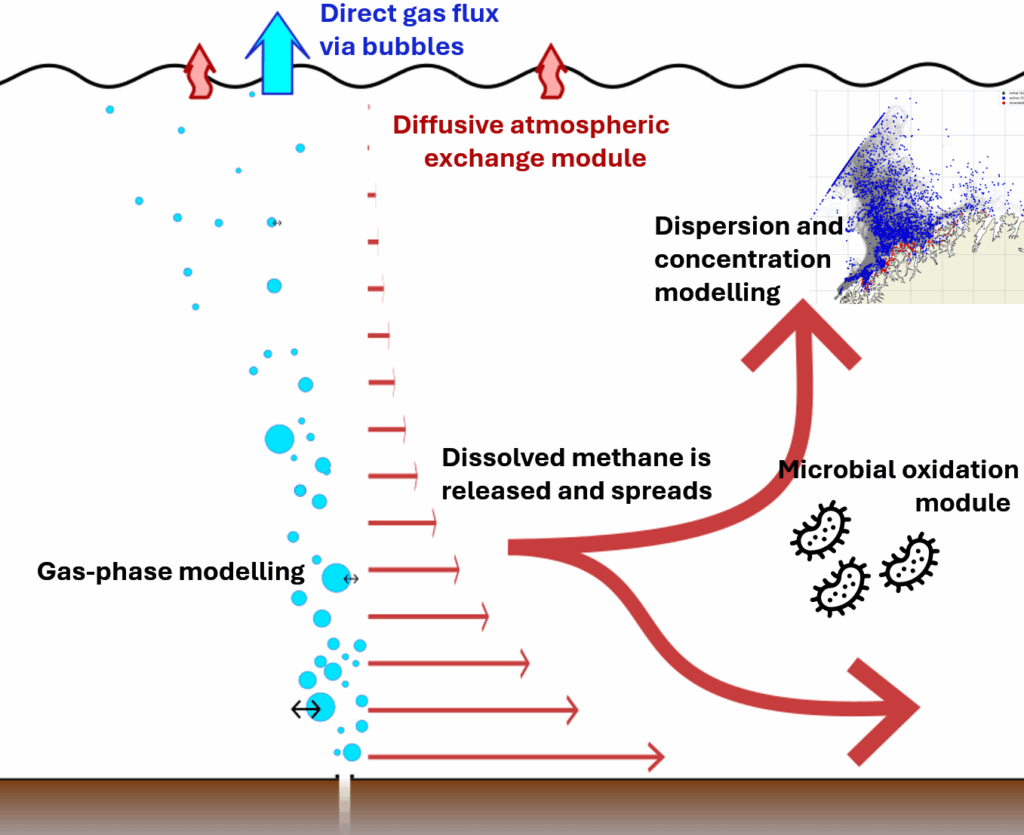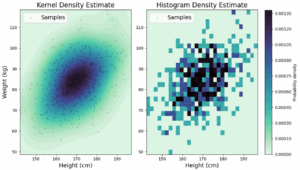When people picture gas leaking from the seafloor, they often imagine plumes of bubbles that make up a direct path from the seabed to the sky. The reality, however, is far more complex and far more interesting. Between the seafloor and the atmosphere lies an entire ocean of physics, chemistry, and biology that controls the fate of the released gas. In fact, typically, most methane is dissolved into the seawater and only a fraction reach the surface directly as bubbles. This naturally raises an important question: What happens to all the dissolved methane? Our team wanted to see if we could model all these processes at once to simulate what happens to gas as it travels from seabed seeps through the water column and into (or not into) the atmosphere.
An important player in the climate system and local ocean ecology
Methane is a powerful greenhouse gas, more than 30 times stronger than carbon dioxide over a century. While we often think of methane emissions as something coming from wetlands, livestock, or fossil fuel extraction, the seafloor can also be a significant source. Natural “cold seeps” and potential leaks related to gas wells or future carbon storage sites can all release methane into the sea. However, most of this methane never reaches the atmosphere as gas bubbles. Instead, it mostly dissolves into seawater and the rest may be released into the atmosphere at a completely different place at a later stage, via diffusive exchange. The dissolved methane may also be oxidized by specialized microbes, and the carbon dioxide generated in this oxidation process can affect local biology – for instance by changing growth rates of cold-water corals.
While we know how individual processes like dissolution or microbial oxidation behave, their combined effect in the ocean remains poorly understood. Capturing this interplay requires models that integrate all these mechanisms within one dynamic framework.
The modelling framework
In our recent study, Modelling water column gas transformation, migration and atmospheric flux from seafloor seepage (Dølven et al., 2025, Ocean Science), we developed a new modular model framework to do just that. Its backbone consists of two main components:
- A bubble gas phase model which simulates the behaviour of gas in bubbles rising from the seafloor – how quickly and where gas dissolves into seawater and how much gas escapes directly to the surface
- A concentration model which tracks what happens to the dissolved gas – how it spreads, how much is consumed by microbes and how much is transported to the atmosphere.
The gas-phase model provides the input for the concentration model. While the gas-phase model already existed, the concentration model had to be developed by coupling existing ocean modelling tools with a statistical estimator and “process modules” for the microbial oxidation and diffusive exchange with the atmosphere (see Figure 1).
Obtaining concentration fields
To estimate dissolved gas concentrations, we used a particle dispersion model. This means that instead of representing gas as a continuous field, we simulate thousands of “virtual particles,” each representing a certain amount of gas molecules. Ocean currents and turbulence simulated by a state-of-the-art 3D hydrodynamic model then determine how these particles are transported and spread through the water. This results in a cloud of particles which shows how the gas moves and spreads out, but not yet the explicit concentration at a given point. To estimate the concentration, we need to know how many virtual particles there are per unit volume. This counting process is less straightforward than it sounds and belongs to a branch of statistics known as density estimation.
The simplest method to do this density estimate would be to divide the ocean into boxes and count how many particles fall into each – this is often referred to as the “Histogram estimator”. However, this approach would require an enormous number of particles to produce a smooth, realistic field. Instead, we developed a kernel density estimator tailored for our particular purpose. Kernel density estimation is a statistical technique that spreads the “influence” of each particle over its surroundings using a mathematical function (the kernel), creating more realistic density estimates for smooth distributions (an example is shown in Figure 2).
Using this technique, and by adapting the kernel sizes to the local particle density, we can therefore reconstruct smooth and realistic 3D concentration fields even with a moderate number of particles.
Explicitly resolving the evolution of the 3D concentration makes this modelling framework very flexible since we can easily integrate additional processes at each modelling time step. These processes can for example be microbial oxidation, chemical reactions, or gas exchange with the atmosphere – which can be represented by their own “module,” allowing the framework to grow and adapt to new applications.
Testing the model: a seep offshore Northwestern Norway
We tested this framework on a natural methane seep site located offshore northwestern Norway, at a depth of about 200 meters by simulating the fate of released methane for one-month starting May 20 and ending June 20, 2018 (Figure 3 or as animation).The results revealed a surprisingly dynamic picture: Most of the released methane (99.7%) dissolved in the water column, predominantly close to the seafloor. Then, within just a few days, the dissolved methane was rapidly transported upward and away from the seep site by upwelling currents and turbulence. In essence, the vertical concentration profile flipped, with the concentration maxima moving from about 200 meters depth to around 10-20 meters, creating favourable conditions for methane to exchange with the atmosphere (Figure 4). Still, only a small fraction of the methane escaped – the most likely fate for a methane molecule was to be consumed by microbes(!). Over the course of our 1-month modelling period, we estimated that about two-thirds (65 %) of methane molecules was consumed by microbes, about one-third (34 %) remained in the water column and only 0.7 % was released to the atmosphere.

Figure 3: Average dissolved methane concentration over the modeling period resulting from the modeled gas seeps.
A very important point in this regard, however, was the sensitivity of our result to changes in our assumptions on how efficient the microbes could consume methane. These rates are highly uncertain and can vary dramatically depending on temperature, nutrition levels, and microbial communities. Changing this single factor can massively alter atmospheric emissions and methane residence times, potentially making diffusive atmospheric release of methane an important sink of methane. The emissions were also spread out over a huge area (Figure 5, or as animation), meaning that even if the seabed seeps caused significant atmospheric release, it would be very difficult to detect.

Figure 5: Horizontal distribution of diffusive atmospheric release of methane resulting from the gas seeps.
Why it matters
Our findings first and foremost highlight how difficult it is to detect methane emissions caused by seabed seeps, due to the distributed nature of the resulting emissions. It also illustrates how the ocean can act as a filter for seafloor gas and how sensitive this filter is to the efficiency of microbes. In our specific case and with our assumptions, it prevents a significant amount of methane from reaching the atmosphere and rather redistributes it and transforms it to carbon dioxide, however this is a topic which requires more study.
Challenges
Like any model, ours depends on many assumptions that introduce uncertainty. As mentioned, one of the largest uncertainties comes from the microbial oxidation rates, which determines how fast the microbes consume methane. An additional problem with the microbial oxidation module lies in its simplicity, by completely ignoring the complex nature of bacterial growth and stock dynamics. Other sources of uncertainty include how well ocean turbulence and gas-exchange rates are represented, as well as how well the model resolves small-scale processes. Addressing these uncertainties will require more field data and collaboration between modelers, oceanographers, and microbiologists. Despite these challenges, the framework’s modular structure and detailed output make it a promising platform for future research.
Outlook
The strength of this framework lies in its ability to bridge scales and disciplines to investigate the dynamics of a complex system – from microscopic interactions at a bubble’s surface to vast ocean currents. By integrating physics, chemistry, and biology, it offers a comprehensive view of how gases move and transform in the marine environment. We hope this free, open and flexible tool can serve both as a foundation for new modelling studies and as practical support for more traditional environmental investigations to improve our understanding of the impact of seabed gas release on the environment.
- You can find the paper here







